
Scilla siberica, the Siberian squill or wood squill, is a species of flowering plant in the family Asparagaceae, native to southwestern Russia, the Caucasus, and Turkey. Despite its name, it is not native to Siberia.

Hyacinthoides italica, the Italian bluebell or Italian squill, is a spring-flowering bulbous perennial plant belonging to the family Asparagaceae.

Ornithogalum dubium, common names sun star or star of Bethlehem, is a species of flowering plant in the family Asparagaceae, subfamily Scilloideae. It is a South African endemic.

Puschkinia is a genus of three known species of bulbous perennials in the family Asparagaceae, subfamily Scilloideae. It is native to the Caucasus and the Middle East. Puschkinia scilloides is grown as an ornamental bulbous plant.
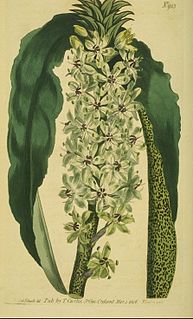
Eucomis comosa, the pineapple flower, pineapple lily or wine eucomis, is a species of flowering plant in the asparagus family Asparagaceae. A deciduous bulbous perennial used as an ornamental plant, it is endemic to South Africa. The white to purple flowers appear in summer and are arranged in a spike (raceme), topped by a "head" of green leaflike bracts.
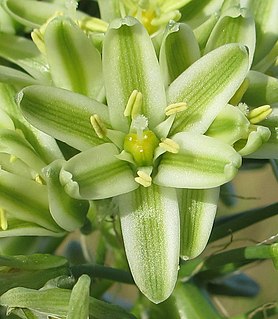
Albuca bracteata, is known by the common names pregnant onion, false sea onion, and sea-onion. It is a species of bulbous flowering plant in the family Asparagaceae. Its flowering stems can reach a height of 90 cm and can carry up to 100 greenish white flowers.
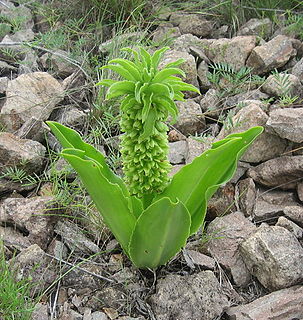
Eucomis is a genus of flowering plants in the family Asparagaceae, subfamily Scilloideae, native to southern Africa. Most species of this genus are commonly referred to as pineapple flowers or pineapple lilies. They are bulbous perennials with basal rosettes of leaves and stout stems covered in star-shaped flowers with a tuft of green bracts at the top, superficially resembling a pineapple – hence the common names.

Eucomis autumnalis, the autumn pineapple flower, or autumn pineapple lily, is a species of flowering plant in the family Asparagaceae, subfamily Scilloideae, native to Malawi, Zimbabwe and southern Africa. It is a mid to late summer flowering deciduous bulbous perennial. The flower stem reaches about 40 cm (16 in), rising from a basal rosette of wavy-edged leaves. The green, yellow or white flowers are arranged in a spike (raceme), topped by a "head" of green leaflike bracts. It is grown as an ornamental garden plant and can also be used as a cut flower.

Eucomis vandermerwei is a South African bulbous perennial flowering plant, a member of the asparagus family, and like other members of Eucomis is commonly known as pineapple lily for its superficial resemblance to that plant, although not closely related to it. This species is one of the smallest in the genus, and is native to a high-rainfall region of western Mpumalanga in South Africa. The dense rosette of leaves, either prostrate or ascending, is heavily blotched with purple, and the leaf-edges are markedly crisped or wavy. The star-shaped burgundy flowers appear in midsummer, and are borne on a spike (raceme) topped by a "head" of leafy bracts.
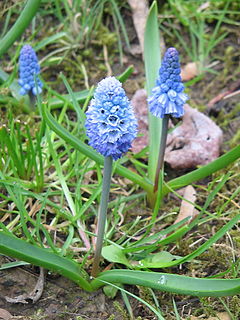
Pseudomuscari azureum, the azure grape hyacinth, is a species of flowering plant in the family Asparagaceae, native to Turkey. A bulbous perennial, it is grown in gardens for its spring flowers. The specific epithet azureum means "bright blue", a reference to its flower colour.

Eucomis bicolor, the variegated pineapple lily or just pineapple lily, is a bulbous species of flowering plant in the family Asparagaceae, subfamily Scilloideae, native to Southern Africa. The pale green, purple-margined flowers are arranged in a spike (raceme), topped by a "head" of green leaflike bracts. It is cultivated as an ornamental bulbous plant, although its flowers have an unpleasant smell, attractive to the main pollinators, flies.

Eucomis pallidiflora, the giant pineapple lily, is a bulbous species of flowering plant in the family Asparagaceae, subfamily Scilloideae, native to southern Africa. The white to green flowers appear in summer and are arranged in a spike (raceme), topped by a "head" of green leaflike bracts. Some forms reach almost 2 m when in flower. The species is cultivated as an ornamental plant, although it is not hardy in areas where severe frosts occur.
Alrawia is a genus of bulbous flowering plants in the family Asparagaceae, subfamily Scilloideae. It is native to north-eastern Iraq and Iran.

Prospero is a genus of bulbous flowering plants in the family Asparagaceae, subfamily Scilloideae. It is distributed in Europe, around the Mediterranean, and through the Middle East to the Caucasus.

Eucomis zambesiaca is a bulbous plant in the family Asparagaceae, subfamily Scilloideae, native to southern Africa, from Zimbabwe through Malawi to the Limpopo Province of South Africa. One of the smaller species in the genus, it has a rosette of leaves about 45 cm (18 in) across and white flowers in a spike to about 30 cm (12 in) tall.
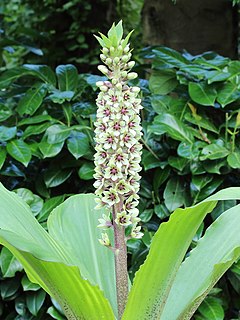
Eucomis montana is a plant species in the family Asparagaceae, subfamily Scilloideae, found in South Africa and Eswatini (Swaziland). When in flower in summer, the plant reaches a height of up to 45 cm, with a dense spike (raceme) of greenish flowers, topped by a "head" of green bracts.
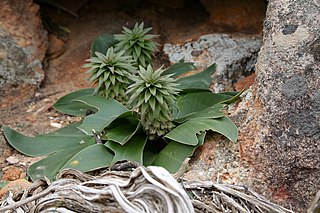
Eucomis regia is a species of bulbous flowering plant in the family Asparagaceae, subfamily Scilloideae, native to the Cape Provinces of South Africa. It is sometimes cultivated, but requires protection in a greenhouse in temperate climates.
Eucomis grimshawii is a species of flowering plant in the family Asparagaceae, subfamily Scilloideae, native to the Cape Provinces. It was first described by Graham Duncan and Ben Zonneveld in 2010.
Eucomis humilis is a species of flowering plant in the family Asparagaceae, subfamily Scilloideae, native to KwaZulu-Natal and Lesotho. It was first described by Baker in 1895. The greenish to purplish flowers appear in summer and are arranged in a spike (raceme), topped by a "head" of green leaflike bracts. Cultivated as an ornamental plant, it can be grown successfully outside where frosts are not too severe.
Eucomis schijffii is a bulbous species of flowering plant in the family Asparagaceae, subfamily Scilloideae, native to the Cape Provinces, KwaZulu-Natal and Lesotho. It was first described by William Frederick Reyneke in 1976. The reddish purple flowers appear in summer and are arranged in a spike (raceme), topped by a "head" of green leaflike bracts. It is cultivated as an ornamental plant and can be grown successfully outside where frosts are not too severe. The smallest of the species of Eucomis, it is particularly suited to being grown in rock gardens or containers.














